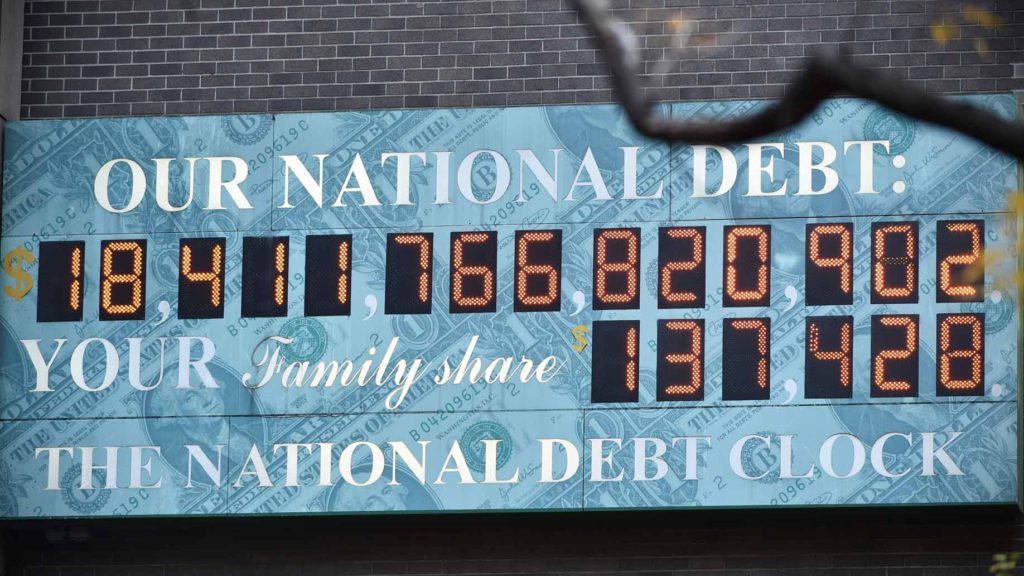 According to projections by the Congressional Budget Office (CBO), America will continue to spend more than it receives in revenues from 2016 to 2026, and perhaps beyond. The budget deficit is projected to be slightly below 3% of gross domestic product (GDP) through 2018, then rise to 4.9% by 2026.
According to projections by the Congressional Budget Office (CBO), America will continue to spend more than it receives in revenues from 2016 to 2026, and perhaps beyond. The budget deficit is projected to be slightly below 3% of gross domestic product (GDP) through 2018, then rise to 4.9% by 2026.
If the CBO projections are accurate, the federal debt will grow another $9.4 trillion by the end of the 10-year period, with potentially dire consequences for the country. According to the authors of the report, “The likelihood of a fiscal crisis in the United States would increase. There would be a greater risk that investors would be unwilling to finance the government’s borrowing needs unless they were compensated with very high interest rates; if that happened, interest rates on the federal debt would rise suddenly and sharply.”
Higher interest rates—averaging 2.3% in 2014 and 2015, as reported by TreasuryDirect—on an increasing amount of debt are likely to cause a “crowding out” effect, according to the Federal Reserve Bank of St. Louis. As the Federal Government borrows more money to pay its bills, there is less capital available for the private sector.
Many believe that the CBO’s concern is understated. In his testimony before the United States Senate Budget Committee February 25, 2015, economist Dr. Laurence J. Kotlikoff of Boston University bluntly stated, “Our country is broke. It’s not broke in 75 years or 50 years or 25 years or 10 years. It’s broke today. Indeed, it may well be in worse fiscal shape than any developed country, including Greece.” Kotlikoff claims that Congress has “cooked the books” for years, and that the difference between the present value of all projected future government expenditures less the present value of all projected future receipts was actually $210 trillion in 2014, more than 16 times the actual reported debt.
Whether or not economists agree on the appropriate level of the federal debt, there is agreement that the only way to reduce annual deficits and pay down the debt is for the government to Collect more than it spends – an unlikely (if not impossible) result in today’s political atmosphere. Only six times between 1960 and 2015 has the Federal Government spent less than it collected, according to the Office of Management and Budget. Most recently, in 2015, the Federal Government collected $3.25 trillion in taxes, almost 60% from income taxes, while spending $3.69 trillion. As a result, the budget deficit of $439 billion—the lowest deficit since 2008—was added to the federal debt.
The Myth of Economic Growth as a Solution
Politicians regularly suggest that the deficit problem can be resolved as the economy improves because revenues through taxes naturally increase as incomes rise through stronger growth. Such thinking encourages postponing actions that are politically unpopular, such as raising taxes or cutting popular programs.
Hoping that economic growth can solve America’s problems is likely futile for the following reasons:
GDP Growth Is Projected to Be Lower Than in the Past. According to the CBO’s Budget and Economic Data, annual growth averaged 3.2% to 3.3% from 1974 to 2001, 2.7% from 2002 to 2007, and 1.4% from 2008 to 2015. While the economy is recovering, the CBO projects average annual growth from 2016 to 2025 at 2.0%, well below the average prior to 2008.
Widening Income Disparity Threatens Economic Growth. The trickle-down theory was discredited by a 2015 International Monetary Fund report, which indicated that when the rich get richer, no others benefit and growth slows. The data from more than 150 nations suggests that when the richest 20% of a society increases their income by 1%, the annual rate of GDP growth shrinks by nearly 0.1% within five years.
Costs for the Major Entitlement Programs Will Rise Sharply. The aging population, rising healthcare costs per person, and increased costs of the Affordable Care Act are likely to boost federal spending for Social Security, Medicare, and Medicaid if current laws remain unchanged. As Kotlikoff testified, the estimated 76 million members of the Baby Boomer generation are already entering a period where each recipient will Collect “$40,000 in Social Security, Medicare, and Medicaid benefits each year.” As a consequence, the largest group of people to put money into the system – the Boomers – will begin taking it out. Left unchanged, Social Security will begin using its surplus funds to pay benefits in 2017 and deplete reserves by 2034.
Interest Costs on Federal Debt Will Triple in the Next 10 Years. According to CBO projections, net interest costs for the federal debt are projected to more than triple from $223 billion in 2015 to $772 billion in 2025.
Projections Do Not Include the Costs of New Wars for Defense Against Terrorism. The Watson Institute of Brown University estimates the costs to date of the wars in Afghanistan, Pakistan, and Iraq at $4.4 trillion, all of which were funded by borrowing. Some analysts estimate the costs of the three wars even higher. The cost of future defense is unknown, but likely to be as high as – if not higher than – past wars.
Read more . . .

 The debate about free trade versus protective tariffs (taxes) has raged for centuries. However, it has become especially virulent as industrialized countries lose an increasing amount of jobs to emerging nations. Free traders, worried about the possibility of new tariffs to protect native industries, predict a trade apocalypse. Reported by TIME, Robert Zoellick, president of the World Bank, claimed, “If we start to trigger a round of protectionism, as you saw in the 1930s, it could deepen the world crisis.”
The debate about free trade versus protective tariffs (taxes) has raged for centuries. However, it has become especially virulent as industrialized countries lose an increasing amount of jobs to emerging nations. Free traders, worried about the possibility of new tariffs to protect native industries, predict a trade apocalypse. Reported by TIME, Robert Zoellick, president of the World Bank, claimed, “If we start to trigger a round of protectionism, as you saw in the 1930s, it could deepen the world crisis.” According to Professor Nolan McCarty of Princeton University, it seems that political rancor today has reached heights not seen since Reconstruction after the Civil War. A Stanford University report found that Americans have become increasingly polarized along political party lines, primarily due to “political candidates relying on negative campaigning and partisan news sources serving up vitriolic commentary.” As a consequence, the report concluded that the level of political animus in the American public exceeds racial hostility.
According to Professor Nolan McCarty of Princeton University, it seems that political rancor today has reached heights not seen since Reconstruction after the Civil War. A Stanford University report found that Americans have become increasingly polarized along political party lines, primarily due to “political candidates relying on negative campaigning and partisan news sources serving up vitriolic commentary.” As a consequence, the report concluded that the level of political animus in the American public exceeds racial hostility. British Prime Minister David Cameron announced a new police/intelligence agency on December 10, 2014, to monitor the “Dark Web,” as reported by The Independent. According to Cameron, “The dark net is the next side of the problem, where pedophiles and perverts are sharing images, not using the normal parts of the Internet we all use.”
British Prime Minister David Cameron announced a new police/intelligence agency on December 10, 2014, to monitor the “Dark Web,” as reported by The Independent. According to Cameron, “The dark net is the next side of the problem, where pedophiles and perverts are sharing images, not using the normal parts of the Internet we all use.”